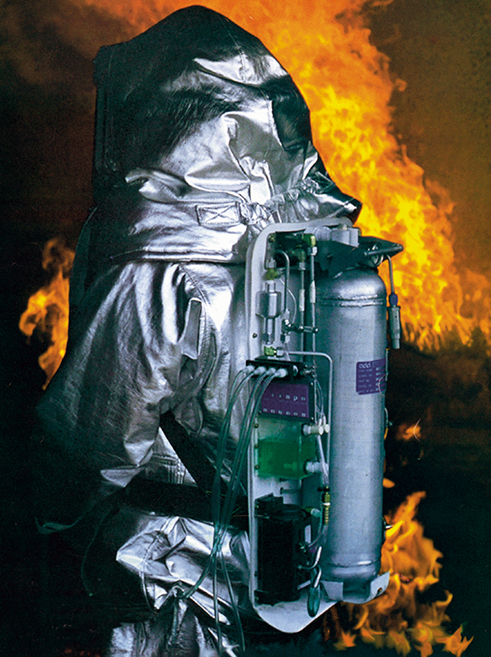Emergency Response Breathing Apparatus
SCAMP® (Supercritical Air Mobility Pack) is a self-contained breathing apparatus (SCBA) that was originally developed under a NASA Kennedy Space Center Small Business Innovation Research (SBIR) contract. The use of supercritical cryogenic air in SCAMP came from the technology developed for the life support fuel cell support systems for both the Apollo and Space Shuttle programs, which required its use in microgravity environments.
In addition to functioning in microgravity, the SCAMP fluid recovery system produces a flow, regardless of the position of the supply tank in Earth's gravity. The SCAMP SCBA system applications are also ground-based, such as those in emergency services and industry.
The developer of SCAMP, Aerospace Design & Development (ADD), Inc., of Niwot, Colorado, was charged with producing a compact breathing apparatus that would meet the needs of Kennedy Space Center rescue personnel. In a launch pad emergency, rescue personnel must be able to crawl through a 20-inch square opening. Therefore, the compact air system required a usage time in excess of 30 minutes, as well as a backpack thickness of less than 5.5 inches.
Many of the propellants used aboard U.S. launch vehicles are toxic to humans. Protective measures, traditionally provided by an SCBA with air as a compressed gas, must be provided to personnel handling these agents and those who must respond to spills or other emergency situations. However, this old technology relies upon heavy, high-pressure cylinders that the emergency worker must carry. ADD extended its development of SCAMP by creating a suit that offers a smaller and considerably lighter system than the older technology. What's more, the longer reserve time provides firefighters and hazardous materials workers greater flexibility and a greater margin of safety.
At the heart of the SCAMP SCBA system is its cryogenic vacuum container, or Dewar, which contains the supercritical air (-320°F) and replaces the standard SCBA high-pressure bottles. The SCAMP SCBA 1-hour Dewar is approximately the size of a standard 30-minute SCBA compressed air bottle, but stores twice the quantity of air, because of its high-density capacity.
ADD's SCAMP achieves both body cooling and breathing from supercritical cold (cryogenic) air, therefore, no additional systems are required. SCAMP absorbs a large fraction of body heat. The heat is transferred from the body to the breathing air through fluid transfer loops between the suit and heat exchangers designed into the SCAMP backpack. This allows for a lighter cooling system with a longer reserve capacity.
This improvement over the traditional SCBA aids both in the reduction of injury, such as heat stress, and increases the possibility of saving lives.
SCAMP® is a registered trademark of Aerospace Design & Development, Inc.

Aerospace Design & Development, Inc.'s SCAMP® is a self-contained breathing apparatus (SCBA) that uses supercritical cryogenic air.













